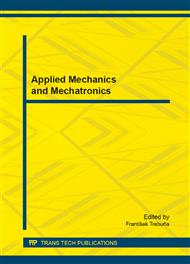p.376
p.387
p.395
p.400
p.405
p.412
p.416
p.424
p.430
Photoelast Method and Possible Applications of Mathematical Statistics in Prediction of Stress State of Structural Elements
Abstract:
The presented article is dedicated to stress state development while assessing the concentration of stresses in samples with continuously changing notches. These samples represent connecting elements of structural parts. The stress states of selected samples were determined experimentally by means of reflection photoelasticity. This method is suitable mainly for determination of stress state in the whole area in question, predominantly though for the analysis of stress concentration and its gradient in the notched area. Within the method of reflection photoelasticity, a layer was used to analyse the stress field. When loaded, this layer exhibits the ability of temporal birefringence. One of the statistical methods was selected in order to predict the stress state of other samples with bigger notches.
Info:
Periodical:
Pages:
405-411
Citation:
Online since:
August 2014
Authors:
Price:
Сopyright:
© 2014 Trans Tech Publications Ltd. All Rights Reserved
Share:
Citation:


